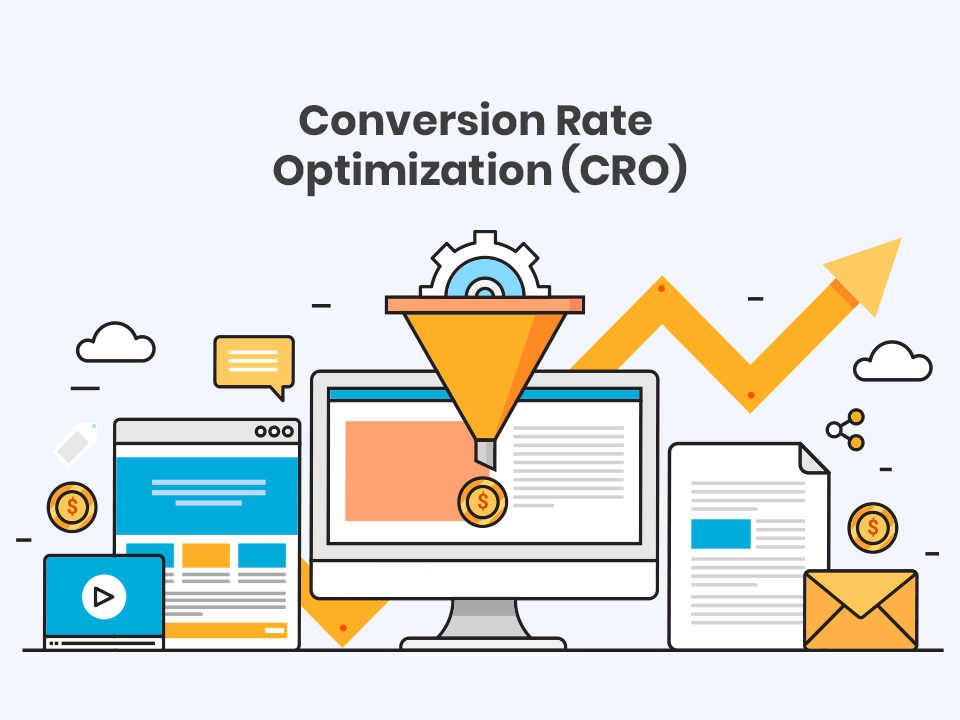What is Conversion Rate Optimization (CRO) and Why It is So Important?

Conversion rate optimization is a marketing optimization process that follows a framework to increase the percentage of visitors who fulfill a website’s goal. It analyses visitor behavior and focuses on finding what motivates a particular market segment to engage in a specific way with specific marketing elements.
Conversion Rate Optimization focuses on convincing more of your website visitors to take the desired action you would want them to take on a webpage, website, or within a campaign.
The right Conversion Rate Optimization methodology can provide amazing results. It is an incredibly effective process to achieve these results through the data-driven, fact-based scientific approach.
What Does Mean By Conversion?
A conversion is a general term for a website visitor completing a site goal. These goals are available in different shapes and sizes. If you employ your website to sell merchandise, the primary goal (the macro-conversion) is for the user to order purchases. A smaller conversion that can happen before a user completes a macro-conversion is abundant in these cases, such as signing up to receive emails. These are called micro-conversions.
Examples of Conversions
Examples of macro conversions
- Buying a product from the website
- Requesting a quote
- Accessing a subscription to a service
Examples of micro-conversions
- Signing up for email lists
- Creating an account
- Adding a product to the cart
What Does Mean By Conversion Rate?
A website’s conversion rate is the number of times a user fulfills a goal divided by the website’s traffic. If you aim to sell a subscription, the number of conversions is to be divided by the number of users.
Conversion rate optimization is accomplished after the visit makes it to your site. This is distinguishable from conversion optimization for SEO or paid ads, which focuses on who clicks to your site from the organic search results, how many clicks you get, and which keywords are directing traffic.
How to calculate the conversion rate?
If a conversion happens each time, users access the site: Imagine you own an eCommerce site — Raymond’s Robotics. A visitor could transact a new purchase each session. The aim is to optimize their experience so they make as many purchases as possible. If a user visited the site thrice, it would amount to three sessions — hence, three opportunities to convert.
Let’s take a closer look at our user’s three sessions and how they behaved:
- Session 1: No conversion. The user was getting familiarized with the site and peeking around.
- Session 2: The user bought a brand-new circuit board. This is a conversion!
- Session 3: The user returned and bought a new set of transistors and a flashing light — another conversion! Even though they purchased two items, this is a unique order and hence counts as a single conversion.
To calculate our conversion rate, the number of unique purchase orders must be divided by the total number of sessions.
To calculate the conversion rate for your site, you’ll look at all unique orders and divide them by the total amount of sessions.
Now, imagine you owned a subsequent site, Raymond’s Monthly Arcade. It sells a subscription for monthly access to a wide array of online games. A user could return and access multiple times, but once they buy a subscription, they won’t convert again.
Let’s look at an example user’s behavior:
- Session 1: The user visited the site for the first time to inspect and familiarize themselves with the service. No conversion occurs.
- Session 2: user subscribes to our monthly Arcade service– this is when a conversion occurs!
- Session 3: The user returns to read blog articles and peek around.
Our users won’t enable a conversion each time they visit the site. So, instead of looking at the number of sessions, we need to calculate your conversion success by the number of visitors:
To calculate our website’s conversion rate, the number of unique orders must be divided by the number of unique users who access the website.
5 Ways Conversation Rate Optimization Benefits SEOs
While not necessarily directly associated with attracting organic website traffic or ranking on a search engine results page (SERP), conversion rate optimization has distinct advantages for Search Engine Optimization. Those include:
- Improved client insights. Conversion rate optimization can assist you in better perceiving your key audience and finding what language or conversational lingo best suits their needs. Conversion rate optimization aims to find the proper customers for your business. Acquiring more people will be unable to profit a business and not do any good if they are not the right people!
- Better ROI: A higher conversion rate means milking more of your resources. By studying how to maximize your acquisition efforts, you will attain more conversions without attracting more potential clients.
- Better scalability: While your audience size may not expand as your business grows, CRO lets you grow without outright depletion of resources and potential customers. Audiences aren’t in incalculable amounts. You can expand your business without losing prospective clients by turning more users into clients.
- Better user experience: Users who feel welcomed and suave on your website tend to stick around. CRO analyses what works on your website. Figuring out what works and focusing on expanding makes up for an even better user experience. Users who feel entitled to your site will interact and engage with it more; some may even become evangelists for your business.
- Enhanced trust: Before a user shares their credit card, email, or any personal details, they have to trust the site veritably. Your website is your foremost salesperson. Like an internal sales team, your site needs to be professional, genial, and proactive in answering customer queries and providing support.
The key to effective optimization
To optimize for conversion rates, you have to know where, what, and what to optimize for. This information is the cornerstone of effective CRO strategies.
If you don’t gather insights, then you’re left making changes based on gut feelings alone. The guts are great! But assuming and deciding on just gut feelings instead of calculated assumptions in data can be a waste of time and resources.
The analytical method
This method, also known as quantitative data analysis, gives you solid data on how people interact and behave on your site. It is safe to start with a promising web analytics platform like Google Analytics. Furthermore, add tracking data for your conversions.
Analytics-based CRO can answer critical questions about how users engage with your site. Quantitative analysis provides data like:
- Where people originate from on your site, i.e., which webpage they land on first
- Which features do they interact with, i.e., where on a page or within your site do they spend their date and time
- What channel and referrer brought them in, i.e., where they found and click on a hyperlink to your site
- What devices and browsers do they use
- Who your customers are (age, interest, and demographic)
- Where users desert your conversion loop, i.e., where or during what activity do users exit your site
This information will let you know where to focus your resources and efforts. You’ll witness a humongous impact by putting your effort into the areas most engaged with and valuable to your users.
The people method
Performing your quantitative analysis first is especially essential if you have a vast site with manifold content. It lets you know, from a numerical perspective, where to converge your efforts. But now that you know how users engage with your site, you can look into the “why” behind their activity.
This people-focused method, known as qualitative data analysis, is more specific. You’ll need the quantitative data discussed beforehand to identify who you should be asking. You can’t optimize for all users, so optimize for your ideal user, the user it’s most crucial to have as a customer.
Ways to get this data:
- On-site surveys
- User testing
- Satisfaction surveys
Qualitative analysis helps optimize for conversions by providing you with information like:
- Why did they engage? Why did they originally decide to access your site or navigate to a particular page? What about the page or product that made them consider a peek into your site?
- What do they think makes your site distinguishable from your competitors? Is there a feature or service your company offers that makes purchasing from you a better experience?
- What words do they use to describe your products, services, and the criticism and issues they address? How would they describe your product or service to an acquaintance? Essentially, how do they talk about what you do?
There are certain things that raw data alone can’t explain about what made a user engage with your site or how to improve their experience. But when you add this information to your analytics data, you can gain a much better comprehension of the pages on your site that present the best opportunities to optimize and engage the audience you’d like to target.
The inaccurate methodology
Some not-so-effective CRO strategies include:
- Guesses, hunches, and gut feelings
- Doing it blindly because your competitor is doing it
All these examples possess something in common: they’re not data-based, and they might even be equated with random shots in the dark. It’s better to collect and analyze the data to create valuable tests based on precise insights. Nobody loves running tests that do not yield success.
The conclusion
You want to obtain most of the available resources regardless of your brand. While SEO can be great for bringing appreciable numbers of visitors to your website, you need to ensure those numbers are valuable and meaningful for your bottom line. This is where CRO comes in.
Effective conversion rate optimization strategies can exponentially increase the number of leads or sales your website generates quickly and expeditiously. A specialized focus on CRO can prove to be more cost-effective than many other strategies for increasing sales, like adding more merchandise or increasing traffic.






